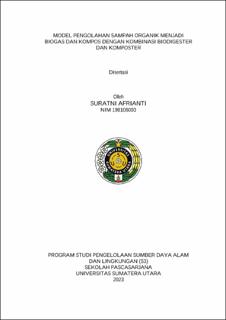| dc.description.abstract | This research explores the utilization of a combination of biodigester and composter as a method for processing organic waste into biogas and compost. The research objectives include analyzing the characteristics of organic waste from restaurants as a raw material for the biodigester and identifying the effluent characteristics of the biodigester after waste processing. Additionally, the study involves analyzing pH, Total Solid (TS), Volatile Solid (VS), CH4, CO2, and biogas volume. Other parameters tested include moisture content, pH, temperature, and nutrient analysis of the compost. The research employed an experimental method in a laboratory setting, with the design of a combined biodigester and composter apparatus. The analysis results were evaluated using Aspen Plus simulation. In the experiments, the most stable conditions were found at a Hydraulic Retention Time (HRT) of 10 days with a pH of 7, resulting in TS, VS, Total Suspended Solid (TSS), and Volatile Suspended Solid (VSS) values of 31.613 mg/l, 22.12 mg/l, 12.62 mg/l, and 10.71 mg/l, respectively. The findings indicated that shorter HRTs such as 10, 20, and 25 days produced higher CH4 concentrations and lower CO2 concentrations. The compost produced from the combination of biodigester and composter met the SNI 19-7030-2004 standards as environmentally friendly organic fertilizer. The best model in Aspen Plus showed a raw material-to-water ratio of 1:10, HRT of 10 days, an operating temperature of 55°C, and the use of a mixer, RCSTR, and Rbatch. The research confirms that the combination of biodigester and composter effectively produces biogas and compost, contributing to the reduction of greenhouse gas emissions and providing significant economic benefits to the community. Therefore, this method serves as an effective alternative in organic waste management | en_US |


